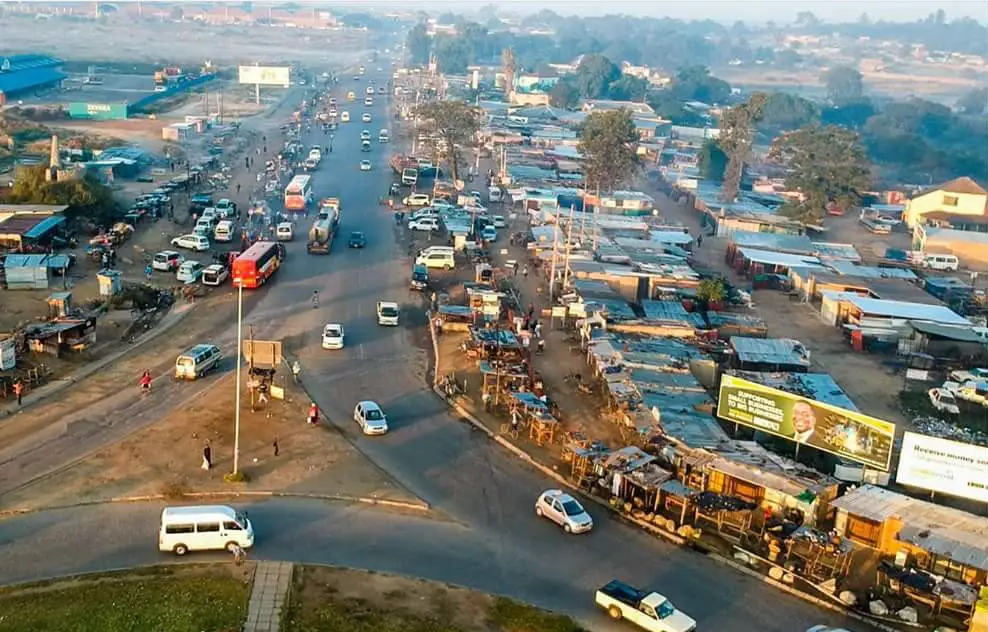Construction on the Mbudzi flyover has accelerated, with contractors currently working on the first section of the real construction, expanding the Glen Norah bridge to house a slip lane leading onto the Harare-Masvingo Highway. The activities are carried out after completing geotechnical engineering tests, which entail obtaining soil and rock samples to determine the strength of materials to be utilized during the foundation stage.
Also Read: Kwekwe to Mvuma electricity transmission line in Zimbabwe gets Chinese funding
The complicated flyover is a significant civil engineering project, and it is critical that the massive reinforced concrete structure be securely attached to the bedrock and can withstand the constant vibration of thousands of heavy cars every day. As of Tuesday, cars were taking turns using Glen Norah Road, which now has only one lane of traffic to allow access to tipper trucks unloading gravel required to drain water and provide room for the bridge’s construction. Caterpillar machinery from the contractors, Tefoma Joint venture, was also clearing soil for the new bridge’s expansion. According to Harare provincial roads engineer Arthurton Zindoga, the contractor is preparing bridges and diversion routes. Workers with Tefoma Joint Venture noted that while preliminary work is being done to establish detour routes, the expansion of the bridge signals the commencement of the main structural work.
Mbudzi Roundabout and Traffic Congestions
Mbudzi roundabout connects Simon Mazorodze, Chitungwiza, and High Glen Roads, which feed traffic from western Chitungwiza and numerous ancient and new neighbourhoods into Harare city centre, as well as major national and regional traffic on the Harare-Masvingo highway. In recent years, the roundabout has experienced traffic congestion, particularly during morning and evening peak hours, forcing most of this traffic to traverse two-thirds of the way around the roundabout, thus barring people on adjacent routes from ever entering the roundabout.
While roundabouts are more efficient than traffic signals at such crossings, they eventually fail, and the next stage is a full interchange with bridges and underpasses that allow all traffic to go without stopping. Slip lanes can accommodate left-hand turns, but the junction must also enable right-hand turning traffic to pass over or under approaching traffic and all direct cross-traffic to pass over or under traffic coming from the right or left.
For many years, the construction of the Mbudzi flyover was touted as the only answer to roundabout congestion, but it has now been shifted from a prospective municipal works project to a Government project, owing to Harare City Council’s lack of ability. The roundabout is clearly the main bottleneck on the Beitbridge-Masvingo-Harare route, and the advantages from the highway upgrade will be limited if traffic is again obstructed.
The roundabout is located on Chitungwiza Route, which not only connects the town to the industrial districts but is also the primary feeder road for the freshly created swath of new suburbs throughout Harare South. High Glen Road connects Harare’s enormous south-western suburbs, which house at least a quarter of the capital’s population, as well as the western sections of the major industrial sector. The combination of all of these demands results in not just heavy traffic, but also large percentages of big vehicles and buses in the traffic.
What we reported in October 2021
Construction of Harare’s Mbudzi Flyover Continues
Following the expiration of Harare City Council’s 48-hour eviction notices, the demolition of unlawfully built homes and tuckshops on road reserves in the Hopley district made way for the Mbudzi flyover’s building, and accompanying roadworks continue.
Also Read: Zimbabwe’s Government Issues Request For Upcoming Housing Project
Approximately 320 homes are being demolished as part of the preparations for the building of a flyover junction to replace the chronically congested Mbudzi roundabout.
On Monday, the bulk of illegal home and tuckshop owners along the Tariro Clinic road reserve continued to destroy buildings on their own, while a few chose to wait and see.
Some demolished whole-farm brick structures, while others just removed roofs, door and window frames, and windowpanes, leaving only the roofs, door and window frames, and windowpanes.
Mr Michael Chideme, a spokesperson for Harare City Council, said yesterday that the council would continue to engage recalcitrant property owners in an effort to guarantee that the project’s construction can proceed without additional disruptions.
“We are going to engage people who continue operating there. We will talk with them until they see reason,” he said. “The idea is not to use the stick, but to engage because we are dealing with human beings. We need to respect each other, we need to respect human dignity and their rights, but eventually, they will move away because of the engagement.”
Cabinet has authorised the Mbudzi flyover and work on repairing and upgrading surrounding roads to provide essential diversionary routes before workers enter the roundabout area has already begun.
This means the Harare City Council must take action to remove the illegal structures, some of which have been allowed to obstruct road reserves for up to six years.
The project’s main emphasis is the new flyover, but it also includes clearing a huge road reservation in the Hopley region, as well as cleaning the road reservation and other municipal land surrounding the proposed interchange construction.

